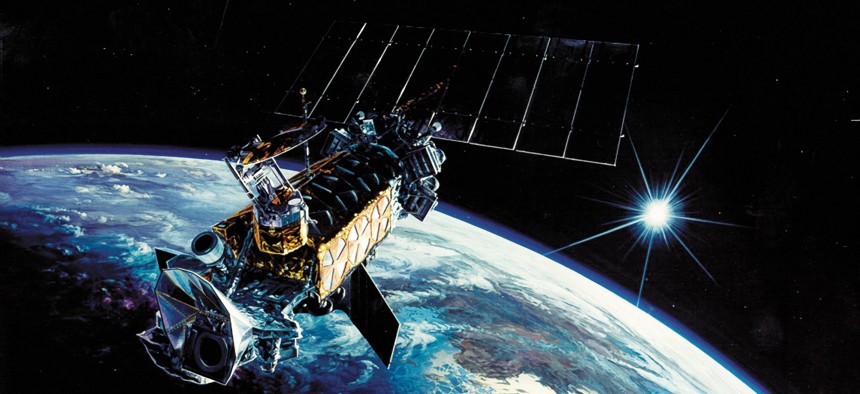
Air Force illustration
Air Force Stands Up Space Mission Force to Counter Russia, China
The service is reorganizing for battle in space, but threats may be progressing faster than fixes.
“Today, two 19-year-old airmen are the two guys flying GPS this morning for the entire world,” the commander of Air Force Space Command told an audience in December. “That’s wrong.”
It’s also about to change.
On Feb. 1, the Air Force will stand up a Space Mission Force at the 50th Space Wing at Schriever Air Force Base, Colorado, the first of several steps meant to put more experienced and ready people in charge of watching U.S. military satellites.
The new force will include 352 people across four squadrons. Half of them will conduct operations while the other half is training. Each squadron will operate with four crews on 12-hour shifts, supported by a mission planning cell that includes orbit analysts, intel professionals, engineers, and mission specialists.
Later this year, the Air Force will stand up two more Space Mission Force crews in Colorado: one at the 21st Space Wing at Peterson Air Force Base and then one at the 460th Space Wing at Buckley Air Force Base.
The Space Mission Force won’t give the wings more personnel. Instead, it will make better use of the skills its people accumulate. Previously, an airman assigned to the wing might serve on a crew, then “graduate” to day staff, a support body whose duties include training, administrative work, technology and program evaluation, etc.
“It used to be that the day staff was actually larger than the crew force,” said Gen. John Hyten, the leader of Air Force Space Command, speaking in December at an Association of Old Crows event. “So now, you’re going to have no day staff but you are going to have two crew forces. So everyone that was on the day staff is going back on the crew. And they’re going back into operational positions.”
The change is one of many that the military is undertaking to beef up its defenses to space assets. It will also boost planned spending on space by up to $8 billion over the next five years. In a recent white paper from the Center for New American Security, or CNAS, Elbridge Colby called this “an especially serious signal of how gravely the Pentagon takes the problem in light of how precious such funds are since the enactment of the Budget Control Act of 2011.”
Of course, the Pentagon has been preparing for space war for decades. Schriever alone has hosted war games for years. But the Space Mission Force represents an entirely different kind of buildup.
“What we’re doing with Space Mission Force, I would suggest that we don’t use ‘wargaming.’ … A war game is often even more theoretical than I’ve described in terms of our engagement. Wargaming is really looking out to the future,” Lt. Col. Toby Doran of Air Force Space Command told Defense One. “In our case, we’re looking at threats that are within the next year or two. We’re really not looking to the five- or ten-year threat … What are the concerns in the immediate future that we need to focus on so we are prepared for immediate threats.”
Those threats include everything from anti-satellite missiles to jamming to lasers. Of these, jamming is the most common and likely, but anti-satellite missiles are improving quickly. In 2007, China shot down one of their own weather satellites in what was seen by many as a provocative display. In 2013, a Chinese missile reached 18,600 miles in space, just shy of the 22,236-mile orbits where U.S. geosynchronous satellites fly. China’s not alone. In November, Russia also demonstrated an anti-satellite missile called the Nudol.
The U.S. military is even keeping an eye on other satellites, like the strangely maneuvering objects described by Brian Weeden, a former officer in U.S. Strategic Command’s Joint Space Operations Center, in an October paper for The Space Review.
“Four Russian space launches in 2013 and 2014 in particular have sparked interest,” Weeden wrote. “Three of the launches placed small Russian military satellites into LEO [Low Earth Orbit]; two of those satellites have conducted RPO activities with Russian rocket stages, and one appears to have ‘bumped’ into the rocket stage near which it was maneuvering. The fourth launch was a Russian military satellite to geostationary Earth orbit (GSO). In the one year since its launch, the satellite has moved several times to different positions in the GSO belt of active satellites. Two of those stops were somewhat close to newly launched Russian satellites, and the third was between and very close to two Intelsat commercial communications satellites.”
The strange maneuvering quickly caught the attention of the U.S. military.
“I can’t talk about that in an open environment,” Hyten told Defense One. “But I can say that we watch it. We watch where it goes all the time.”
He said the military trades information about the satellites with Intelsat.
In this dynamic threat environment, CNAS’ Colby wrote, personnel changes aren’t enough. He argues that the United States should develop a strategy for a limited war in space. It might involve the development of more offensive space weapons, or just policy to take action on earth as a consequence of events that happen in orbit. The bottom line, the policy should be firm, known, and have teeth.
“The United States should continue to make clear that it would regard any attacks in space as constituting a grave form of escalation. But it should back that assertion with an ability to fight and prevail in a limited war in space. Nothing would be so likely to prevent any such war from happening, or to limit its baleful consequences should it break out, as a clear ability to do just that,” he writes.







